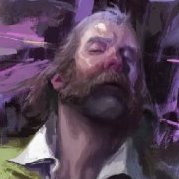Everything posted by VoivodBG
-
Svi žanrovi osim metala
- Nedeljna lista - predlozi
- Najgluplji & najgori filmovi
Znate onaj momenat kada recimo gotivite scenaristu, a u pitanju Max Landis, koji je zaista dobar "pitcher" ideja za scenarije( pogledajte njegov uptomyknees youtube kanal, ima tu generalno dobrih saveta za scenariste), ali mu se retko desi da film koji posle naprave po tom scenariju bude dobar. Ali sama premisa o pandurima koji žive sa natprirodnim bićima u našem svetu na papiru je delovala kao da ne može da omane, međutim ili su se ovde previše umešali David Ayer i Netflix i seckali i preuređivali, ili je sam Max podbacio, ko će ga znati... Najveća greška je što su odabrali Will Smith-a za glavnu ulogu, ne sporim da je tokom 90-tih i 00-tih bio u većini blokbastera kojima mogu povremeno da se vratim i da uživam, pa je čak i kasnije glumio u nekim "ozbiljnim" filmovima, ali se ovde tačno vidi kako je njegova harizma isčilela i da je mator i premoren i jednostavno više nije za ovakve stvari. Sa druge strane pohvalio bih Joel Edgerton-a, večitog underdoga, koji ovde osim što mora da glumi "ha-ha" lika, i nosi kilo prostetike na licu, uspeva najviše da izvuče iz filma u ulozi Orka. A onda ponovo imate i Noomi Rapace koja se tokom godina dokazala kao vešta glumica, sposobna da odglumi svašta, i ovde joj daju samo sjajan kostim i tek 6 rečenica i ništa! Jebeš to. Fabula je poprilično izanđala forma buddy cop filmova, koji su skoro izumreli (dok je Shane Black živ, sve će biti u redu!) i traje predugo, moglo je to više da se krati i da bude kompaktnije. Jedino što bih pohvalio je fotografija, montaža, osvetljenje i kostimografija. Ako je neko do sada gledao Ayer-ove filmove zna da preferira da mu sve izgleda sirovo i jeftino i da kamera bude totalno haotična, a montaža kokainska. Barem je ostavilo nešto pozitivan utisak. Preskočite. Bolje gledajte The Punisher seriju.- Ždranje u Beogradu
Nisam još probao. Ali diči se time na reklami.- Svi žanrovi osim metala
Kada smo već kod Laswell-a. Praxis, Bootsy Collins, Buckethead i ostatak kompanije, muzička dobrota!- Ždranje u Beogradu
Night Prowler, prvih 5 meseci je bilo odlično, posle kada su počeli da menjaju osoblje, pogotovo majstore za meso, opao im je kvalitet, mislim da je stojalo u početku da se samo renoviraju kada sam prošao pre mesec i po dana, a sada je na tom mestu neki novi lokal, Vukadin, navodno zlatiborski roštilj.- Vampire: The Masquerade
Skoro sam skinuo Gog verziju igre i ponovo sam krenuo da je pikam. Iako je ostarila grafički i ima i dalje bagova, čak iako su mnogi prepeglani od strane fanova, ovo je jedna od neverovatnih igara koju ne treba zaboraviti. Đavolski je zabavno što može toliko puta da se odigra i da ne dosadi. Elem, kopao sam po internetu informacije o igri i našao interesantan intervju sa tipom koji je radio originalni OST: Rik Schaffer: Hello everyone. Ask anything. Q: This has been probably asked a lot, but was the similarity between the VTM: Bloodlines Theme and Massive Attack's Angel intentional? Rik Schaffer: Yep. When I started the project, that was the placeholder track they had in for like a year. They were married to it, but couldn't get the rights. They said make something similar. I hate copying artists, but made it kind of my own. Q: Do you prefer composing music traditionally , while playing instruments, or do you do it digitally right now? Rik Schaffer: I don't write music or read music. Self taught. Everything starts in my head, then the guitar and piano are enemies until I find it. With the atmosphere compositions, those were started on synths or non traditional instruments. Q: What do you think of poems based on gameplay from games? What music should go with it? Say if it is based on Bloodlines? Rik Schaffer: Poems of Bloodlines and Vampires? Dark, brooding, sexual, but not Count Chocula. Q: If you could... Would you make new music to Vampire: the Masquerade Bloodlines? Like adding new musical scores to diverse [sic] the current amazing music already in the game? / Did you use any music samples when making the soundtrack? Rik Schaffer: I couldn't. That music wasn't even a game score. It was an album. I'm not that guy, or in that place anymore. I was broke, living on a couch, out of rehab and jail and living in Hollywood. Basically a character of the game. Q: What's your favorite track from Bloodlines? I was listening to the Chinatown theme earlier.. so good! Rik Schaffer: Hollywood Hub, wrote it a day after being released from jail. I was in the worst depression of my life, it captured it. Q: What was the inspiration for Santa Monica theme track? First part is kind the night itself, mood and mysterious, and second part makes you crap your pants because it's so scary and strange? Rik Schaffer: SM theme - Started on a Fender electric Rhodes piano with that sample riff, watching the game I realized it needed to evolve from a simple sparse "jazz" to evil. Q: Besides the opening theme, did you have any other influences on the soundtrack? Some years ago I could swear I heard something familiar, but I've of course forgotten what it was now. Rik Schaffer: Influences: The Omen soundtrack, Fight Club score, Pink Floyd, substances.I've worked on 140 games in 20 years, either scoring, sfx design or voice over. Lots of VO. Bloodlines is in the top 3 ever. Q: Have you played the game? What's your favorite clan? Rik Schaffer: I liked the class that were schizo and talk off. My wife voiced some of those in the game. Yes, Malks. Q: How is living in Hollywood for you? Did you capture your own thoughts on the district in Hollywood theme? Rik Schaffer: I moved out of Hollywood in 2004 to a peaceful suburb in the Valley. My wife was pregnant and we didn't want to raise kids in Hollywood. Plus the temptations for me. Q: Your wife's lucky. I'd love to get into voice acting and work on something like this. Rik Schaffer: My wife was the casting director for Bloodlines and tons of other games. We do more VO gigs than anything else these days. Q: Do you think you're done with video game music? Would it have to be something special to bring you back? Rik Schaffer: I'm done composing because I can't beat Bloodlines. As an artist I found writing was fresh and I was edgy and prolific again. If my screenplay gets sold, I'll score it. Or if Bloodlines two or something similar came up, but even then I'm not a depressed down and out twenty five year old... I've been approached by a number of "Vampire" type projects over the years. Q: What did you do to go to jail? Rik Schaffer: The drug dealers are the real bloodsuckers. Q: Do you agree that the best things come up the creative minds while being in a low? In the worst moments of life? Rik Schaffer: I started using drugs as a young guitar player when I was touring. Thinking all my heroes did it and I needed it to get to that place. But I found being in a depression and having life throw curveballs at you makes creativity flow. I write on weed sometimes, but primarily I think THE MOST important thing is to be born with a surreal mind that generates creative ideas. Sometimes I want to stop my mind, but I am blessed it creates. Thanks again everyone. Take care and create!- HIP-HOP
- Svi žanrovi osim metala
- Domaća scena - predlozi
- Najlepše žene u svijet
Doris Yeh - Chthonic- Tribulation
http://youtu.be/9rgbc-OJcCU situacija se popravlja!- Uređenje enterijera
- Pogavranjen
- Cynic
- Tema za shabanski HIP HOP
- E-Play
Ili na jedno 15-20 disketa. Da imam bend i da lupim ovakvu izjavu pri kraju zapitao bi se da li mi je opao šećer ili da li je potrebna poseta do doce na privatne razgovore. I dalje ne zna da peva i pokušava da se progura, mada moram priznati da je Varalica odradio solidan posao što se tiče produkcije. Barem neka svetla tačka.- E-Play
- Najlepše žene u svijet
- Svi žanrovi osim metala
- Obojeni Program
Prvi singl sa novog live albuma! Obojeni Program će krajem decembra objaviti live album "Exit 2017" (Odličan Hrčak - Srbija, Dallas Records - Slovenija i Hrvatska), vinilno izdanje u ograničenom tiražu. Koncertna promocija albuma biće u sali Amerikana Doma omladine Beograd u subotu, 23. decembra. U četvrtak, 14.12. u 20.00 ćete na ovoj stranici moći da pogledate spektakularan nastup sa Main Stage-a Exit festivala prošlog leta. https://www.youtube.com/watch?v=j8Zew97R7OM&feature=youtu.be- Kandakodžainebojša
http://youtu.be/kI9rbkY3zsI definitivno su spustili loptu sa ovom pesmom....- Heretic Rites
Account
Navigation
Search
Configure browser push notifications
Chrome (Android)
- Tap the lock icon next to the address bar.
- Tap Permissions → Notifications.
- Adjust your preference.
Chrome (Desktop)
- Click the padlock icon in the address bar.
- Select Site settings.
- Find Notifications and adjust your preference.
Safari (iOS 16.4+)
- Ensure the site is installed via Add to Home Screen.
- Open Settings App → Notifications.
- Find your app name and adjust your preference.
Safari (macOS)
- Go to Safari → Preferences.
- Click the Websites tab.
- Select Notifications in the sidebar.
- Find this website and adjust your preference.
Edge (Android)
- Tap the lock icon next to the address bar.
- Tap Permissions.
- Find Notifications and adjust your preference.
Edge (Desktop)
- Click the padlock icon in the address bar.
- Click Permissions for this site.
- Find Notifications and adjust your preference.
Firefox (Android)
- Go to Settings → Site permissions.
- Tap Notifications.
- Find this site in the list and adjust your preference.
Firefox (Desktop)
- Open Firefox Settings.
- Search for Notifications.
- Find this site in the list and adjust your preference.
- Nedeljna lista - predlozi





